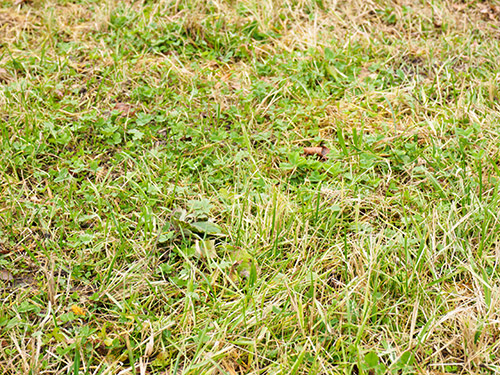21 June 2022

There are many different causes why grass can turn yellow. Whether the yellowing invades small patches or the entire lawn, it’s essential to know the reasons behind it. And, your keenness into the details of yellowing can lead to the right diagnosis of the problem at hand.
Next are the main causes of yellowing in grass that you need to know:
Nutrient deficiency is a common cause of yellowing in the grass. The primary nutrients that your lawn needs for good health include nitrogen, potassium, and phosphorous. Of course, iron, among other vital micronutrients, is also required in the right quantities.
If one of these nutrients is lacking, the grass in your lawn is likely to yellow. Besides yellowing, nutrient deficiency also makes the grass have inconsistent growth that can be unsightly.
With that being said, soil tests are a must to know which nutrient is missing. At this point, seek the services of a lawn care professional and don’t just make assumptions.
Notably, nitrogen and iron deficiencies account for most problems of lack of enough nutrients in the soil. When the problem occurs in patches, that’s possibly an iron deficiency. If it’s the entire lawn, nitrogen is the big culprit.
As much as it’s a textbook practice for lawn maintenance, fertilizer application might be the undoing. If applied in excess amounts, nitrogen fertilizers could burn the grass before it yellows and dies. Excess nitrogen fertilizer increases soil acidity. What happens is that a pH imbalance that doesn’t favor proper lawn growth is created. Too much acidity leads to yellowing of the lawn. In the end, areas that received excess fertilizer experience unpleasant yellowing spots.
In the same way, less fertilizer application means fewer nutrients are added to the soil, hence yellowing.
The grass in your lawn can turn yellow due to overwatering. Too much water in the lawn leads to waterlogging conditions.
Under such conditions, the grass won’t have enough oxygen to respire, hence poor root development. If this happens, the grass won’t be able to uptake essential nutrients and water, and this causes yellowing.
When there’s too much water on the lawn, the likelihood of disease is high. Fungal infections are prevalent in conditions of excess moisture.
As will be explained later, lawn disease is another leading cause of yellowing. So you want to strike a good balance of water in your lawn.
Another cause of yellowing features damage to the grass by pests. Insect pests eat grass leaves and roots.
If these insects start feeding the grass from the base or roots, it yellows, turns brown, and eventually dies off. Common insects that cause this damage include grubs, clinch bugs, and armyworms. You need to scout the lawn and see if these insects are the problem. You can undertake simple DIY tests to determine whether they’re causing the issue or not and take measures to eliminate them.
Remember that some insects are tiny and can’t be easily seen. So, your inspection must be thorough when identifying such insects or bugs.
Sometimes, your grass could be yellowing due to a disease invasion. The big suspect when it comes to diseases in the lawn is fungi.
They cause leaf spots, fairy rings, mold, and smut on the lawn. Fungal infections thrive in wet conditions when the grass has too much moisture. Yet, this is a ripple effect of overwatering the lawn.
You need to water your lawn, especially in the dry season, but fungal diseases come on board if it’s overdone.
It’s important to note that fungal infections on the grass spread very fast. If not controlled in time, they could infect the whole lawn, which would mean a lot of work eliminating the problem.
As mentioned earlier, grass needs enough water to grow healthy and strong. If the supply of water is limited, there’s poor growth. Eventually, the grass becomes weak and unable to uptake nutrients efficiently.
In the end, it starts to turn pale green and yellow, indicating inadequate water and nutrients. The rains may not be enough, especially in the summer when hot conditions prevail the most.
If these conditions persist and the grass isn’t receiving enough water, the grass becomes dehydrated. It then loses its greenish hue and turns yellow.
This means water is required to supply moisture for the grass. If you don’t water the lawn, it dies sooner than later.
Another likely cause for the yellowing of grass in the lawn is animal urine. Generally, animal urine has a lot of nitrogen compounds.
If your pouch and mules keep peeing on the grass every other time, the spots can eventually change the color to yellow. Notably, the nitrogen in the urine increases acidity in the soil at that specific spot.
Lawn dormancy is yet a possible cause of this problem. As the harsh freezing conditions of winter and scorching conditions of summer set in, the grass can switch into a ‘sleep mode’ to avert them.
The grass starts to yellow by lying dormant, keeping a low profile of growing activity limited to root growth. During this time, the grass uses water in measured quantities and efficiently to ensure it isn’t running dry.
Don’t stop watering if you notice this is the state of your lawn. If you cut off the water supply, you make it hard for your lawn to survive through harsh spells.
Soil compaction is another severe cause of yellowing in the lawn. It comes as a result of walking on the grass frequently.
When this happens, the soil particles are packed down close to each other. This reduces soil porosity and aeration.
Roots find it difficult to penetrate the compacted soil. So, they don’t grow well to absorb essential nutrients. What happens from there is yellowing since grass won’t uptake these nutrients.
Tune in next week to see how to fix yellow grass.
Source: lawncareguides.com